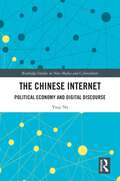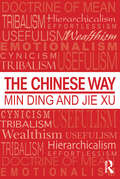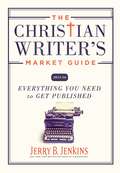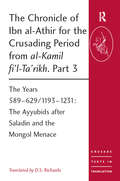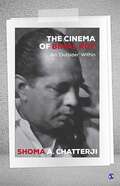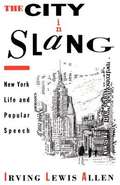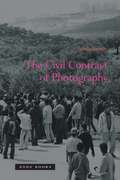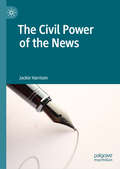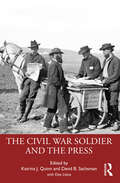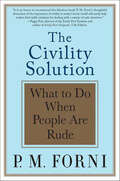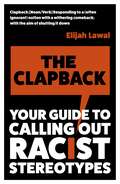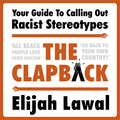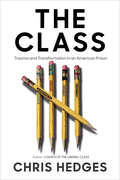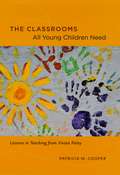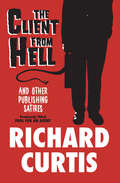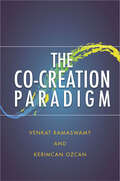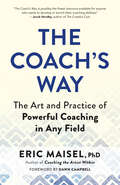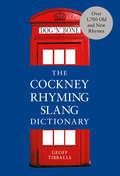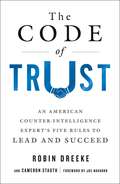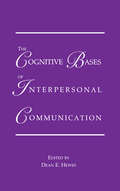- Table View
- List View
The Chinese Internet: Political Economy and Digital Discourse (Routledge Studies in New Media and Cyberculture)
by Yuqi NaThis book explores China’s digital discourse and how the Internet influences social and ideological changes to the country’s political economy, within China’s historical context and through a variety of social and political actors. Analysing discourses as diverse as policy papers, addresses from the Xi-Li Administration, speeches from CEOs of the dominant Internet companies in China, as well as those of Chinese citizens, the book illuminates the dynamics, complexity, and structural contradictions in China’s current network technology-enabled developmental path through the lens of ideology and discourse. The book proposes a multi-dimensional model to understand Marxist ideologies under capitalism, emphasising the relevance of alienation, commodity fetishism, and reification in contemporary discussions of ideology and discourse. This insightful study offers fresh insights into Chinese digital discourse and will be of interest to upper-level students and scholars of communication studies, digital media, sociology, political science, and internet and technology studies.
The Chinese Way: Walked Out Of The New Way Of Cancer Treatment With Immune Regulation And Control Of Combination Of Chinese And Western Medicine
by Min Ding Jie XuAs business becomes increasingly globalized and China establishes its growing role in the international business environment, developing an understanding of the complex culture is important to anyone acting in the global arena. This book offers readers a thorough and nuanced resource to that end, describing the ever-evolving Chinese way of life circa 2014, based on extensive primary and secondary data. Taking an anthropological approach to achieve a well-rounded representation, the book covers 51 topics that would have been studied if China were a newly discovered civilization. It explores the culture through its examination of the nine core concepts that best represent the Chinese way of life. While the book is a rigorous treatment of the Chinese way of life, it is also filled with personal stories and perspectives from close to 1000 successful Chinese from academia, business, and government. The Chinese Way equips international business students, scholars, and practitioners with a deep understanding of a society that is a major player in global business today and offers a foundation for successful business interactions with Chinese companies, organizations, and people.
The Christian Writer's Market Guide 2015-2016
by Jerry B. JenkinsFor more than 25 years, The Christian Writer's Market Guide has been the most comprehensive and highly recommended resource available for Christian writers, agents, editors, publishers, publicists, and writing teachers. Wherever an author is at on the spectrum of writing--from beginner to seasoned professional--this book will help them find what they are looking for. This is the must-have tool for getting noticed and published and the ultimate reference tool for the aspiring Christian writer. Detailed listings for more than 180 book publishers, subsidy publishers, and self-publishers Detailed listings for more than 170 periodicals by category with rates of pay Detailed listings for literary agencies, writing contests, conferences, workshops, editorial services, and writers' groups Extensive information on electronic and print-on-demand publishing 100 bonus pages filled with a wealth of how-to information, ideas, and tips
The Chronicle of Ibn al-Athir for the Crusading Period from al-Kamil fi'l-Ta'rikh. Part 3: The Years 589–629/1193–1231: The Ayyubids after Saladin and the Mongol Menace (Crusade Texts in Translation)
by D. S. RichardsThe Chronicle of Ibn al-Athir (1160-1233AD), entitled "al-Kamil fi'l-Ta'rikh", is one of the outstanding sources for the history of the mediaeval world. It covers the whole sweep of Islamic history almost up to the death of its author and, with the sources available to him, he attempted to embrace the widest geographical spread; events in Iraq, Iran and further East run in counterpoint with those involving North Africa and Spain. From the time of the arrival of the Crusaders in the Levant, their activities and the Muslim response become the focus of the work. A significant portion of this third part deals with the internal rivalries of the Ayyubid successors of Saladin, their changing relations with the Crusader states and in particular the events of the Damietta Crusade. As always, these events are portrayed against the wider background, with considerable emphasis on events in the eastern Islamic world, the fortunes of the Khwarazm Shahs and the first incursions of the Mongols.
The Cinema of Bimal Roy: An ′Outsider′ Within
by Shoma A. ChatterjiAn analysis of Bimal Roy’s films and their depiction of people outside the ‘mainstream’ The Cinema of Bimal Roy: An ‘Outsider’ Within examines Roy’s adaptations of Bengali and Hindi literary classics while dwelling on his approach and treatment of women, a focal point of many of his films. It draws attention to his cinema of social relevance—untouchability (Sujata), woman deserted by society and family (Biraj Bou), child marriage (Parineeta) and the inhumanity of oppression and forced urbanization (Do Bigha Zameen). The book goes on to discuss Roy’s ability to bestow new screen identities to established actors such as Nutan, Meena Kumari and Dilip Kumar on one hand and discover new talents such as Sunil Dutt, Sadhana and Tarun Bose on the other. Apart from this, his tutelage introduced many new faces to the film industry—Salil Choudhury, Hrishikesh Mukherjee, Nabendu Ghosh and Gulzar among others. Further, the book details the aesthetics of technique—cinematography, editing and sound—in Roy’s films; his movies had some of the best musical scores in Hindi cinema. It also analyses what made Madhumati his biggest commercial success.
The Citizen Journalist's Photography Handbook: Shooting the World As it Happens
by Carlos MillerWith dramatic and exciting stories, Carlos Miller reveals the secrets behind successful citizen journalism.Whether you're planning a publicity blitz for your cause, you're interested in the down-and-dirty practices of the police, or just want to be prepared for the moment you're the first on the scene, this book has everything you'll need to know to take newsworthy pictures and get them in front of a wide audience.You don't need a DSLR camera - though they can be useful - what is essential for citizen journalism is a cool head, an eye for a great angle, and the initiative to capture the moment: let Carlos Miller show you how.
The City In Slang: New York Life And Popular Speech
by Irving Lewis AllenThe American urban scene, and in particular New York's, has given us a rich cultural legacy of slang words and phrases, a bonanza of popular speech. Hot dog, rush hour, butter-and-egg man, gold digger, shyster, buttinsky, smart aleck, sidewalk superintendent, yellow journalism, breadline, straphanger, tar beach, the Tenderloin, the Great White Way, to do a Brodie--these are just a few of the hundreds of popular words and phrases that were born or took on new meaning in the streets of New York.<P><P>In The City in Slang, Irving Lewis Allen traces this flowering of popular expressions that accompanied the emergence of the New York metropolis from the early nineteenth century down to the present. This unique account of the cultural and social history of America's greatest city provides in effect a lexicon of popular speech about city life. With many stories Allen shows how this vocabulary arose from city streets, often interplaying with vaudeville, radio, movies, comics, and the popular songs of Tin Pan Alley.<P> Some terms of great pertinence to city people today have unexpectedly old pedigrees. Rush hour was coined by 1890, for instance, and rubberneck dates to the late 1890s and became popular in New York to describe the busloads of tourists who craned their necks to see the tall buildings and the sights of the Bowery and Chinatown. The Big Apple itself (since 1971 the official nickname of New York) appeared in the 1920s, though first in reference to the city's top racetracks and to Broadway bookings as pinnacles of professional endeavor. Allen also tells fascinating stories behind once-popular slang that is no longer in use. Spielers, for example, were the little girls in tenement districts who danced ecstatically on the sidewalks to the music of the hurdy-gurdy men and, when they were old enough, frequented the dance halls of the Lower East Side.<P> Following the trail of these words and phrases into the city's East Side, West Side, and all around the town, from Harlem to Wall Street, and into the haunts of its high and low life, The City in Slang is a fascinating look at the rich cultural heritage of language about city life.
The Civil Contract of Photography
by Ariella AzoulayIn this groundbreaking work, Ariella Azoulay thoroughly revises our understanding of the ethical status of photography. It must, she insists, be understood in its inseparability from the many catastrophes of recent history. She argues that photography is a particular set of relations between individuals and the powers that govern them and, at the same time, a form of relations among equals that constrains that power. Anyone, even a stateless person, who addresses others through photographs or occupies the position of a photograph’s addressee, is or can become a member of the citizenry of photography.The crucial arguments of the book concern two groups that have been rendered invisible by their state of exception: the Palestinian noncitizens of Israel and women in Western societies. Azoulay’s leading question is: Under what legal, political, or cultural conditions does it become possible to see and show disaster that befalls those with flawed citizenship in a state of exception? The Civil Contract of Photography is an essential work for anyone seeking to understand the disasters of recent history and the consequences of how they and their victims are represented.
The Civil Power of the News
by Jackie HarrisonThis landmark book is concerned with the civil power of the news. This power can be seen in the ways the news engages with public sentiment through a focus on three invariant civil concerns: identity, legitimacy and risk. The book analyses how news stories engage with these concerns to make civil and anti-civil judgements, which influence public sentiment and determine the boundaries we place and maintain around the society we live in. Through historical and contemporary examples of this boundary shaping and maintenance, The Civil Power of the News presents a bold and original account of the architecture of news, the influence it has on our conceptions of civility, and, ultimately, the power it wields.
The Civil War Soldier and the Press
by David B. Sachsman Katrina J. Quinn Dea LisicaThe Civil War Soldier and the Press examines how the press powerfully shaped the nation’s understanding and memory of the common soldier, setting the stage for today’s continuing debates about the Civil War and its legacy. The history of the Civil War is typically one of military strategies, famous generals, and bloody battles, but to Americans of the era, the most important story of the war was the fate of the soldier. In this edited collection, new research in journalism history and archival images provide an interdisciplinary study of citizenship, representation, race and ethnicity, gender, disability, death, and national identity. Together, these chapters follow the story of Civil War soldiers, from enlistment through battle and beyond, as they were represented in hometown and national newspapers of the time. In discussing the same pages that were read by soldiers’ families, friends, and loved ones during America’s greatest conflict, the book provides a window into the experience of historical readers as they grappled with the meaning and cost of patriotism and shared sacrifice. Both scholarly and approachable, this book is an enriching resource for undergraduate and graduate courses in Civil War history, American history, journalism, and mass communication history.
The Civil War Soldier and the Press
by David B. Sachsman Katrina J. Quinn Dea LisicaThe Civil War Soldier and the Press examines how the press powerfully shaped the nation’s understanding and memory of the common soldier, setting the stage for today’s continuing debates about the Civil War and its legacy.The history of the Civil War is typically one of military strategies, famous generals, and bloody battles, but to Americans of the era, the most important story of the war was the fate of the soldier. In this edited collection, new research in journalism history and archival images provide an interdisciplinary study of citizenship, representation, race and ethnicity, gender, disability, death, and national identity. Together, these chapters follow the story of Civil War soldiers, from enlistment through battle and beyond, as they were represented in hometown and national newspapers of the time. In discussing the same pages that were read by soldiers’ families, friends, and loved ones during America’s greatest conflict, the book provides a window into the experience of historical readers as they grappled with the meaning and cost of patriotism and shared sacrifice.Both scholarly and approachable, this book is an enriching resource for undergraduate and graduate courses in Civil War history, American history, journalism, and mass communication history.
The Civility Solution: What to Do When People Are Rude
by P. M. ForniThe acclaimed author of The Choosing Civility returns to the subject of common decency and thoughtful behavior.Many of us find ourselves confronted with rudeness every day and don't know how to respond. From the intrusive cell-phone user who holds loud conversations in public to the hostile highway driver who cuts one off with a quick swerve of his car, politeness seems to be on a downward spiral, surprising us at every turn.P.M. Forni, the author of Choosing Civility, has the answer. He knows that rudeness begets rudeness and, in The Civility Solution, shows us what to do when confronted with bad behavior by being assertive as well as civil. In more than one hundred different situations, he shows us how to break the rudeness cycle by responding to a variety of confrontations from bullying to rude internet behavior or the hurtful words of an insensitive family member. How would you respond to the following?…A salesperson ignores your requests…A fellow driver gives you the infamous "finger"…Your child's playmate misbehaves …Your boss publicly reprimands youP. M. Forni has solutions for all of these and many more. In yet another simple and practical handbook, P. M. Forni presents logical solutions that reinforce good behavior and make our world a more civil place.
The Clapback: Your Guide to Calling out Racist Stereotypes
by Elijah LawalClapback: [Noun / Verb] Responding to a (often ignorant) notion with a withering comeback; with the aim of shutting. it. down.___________In order to have an honest and open conversation about race, we need to identify areas where things are not right. The Clapback: Your Guide to Calling Out Racist Stereotypes examines the evolution of the negative stereotypes towards the black community and arms you with the tools to shut them down once and for all. Taking readers on a journey through history, and providing facts and detailed research, this is an eye-opening and refreshing look at race and language. With a light-hearted, razor sharp wit and a refreshing honesty, The Clapback is the handbook the world needs - dishing out the hard truths and providing a road map for bringing some 'act right' into our everyday lives.It's time to Clapback.
The Clapback: Your Guide to Calling out Racist Stereotypes
by Elijah LawalA definitive guide to calling out racial stereotypes and understanding the meaning behind them___________Clapback: [Noun / Verb] Responding to a (often ignorant) notion with a withering comeback; with the aim of shutting. it. down.___________In order to have an honest and open conversation about race, we need to identify areas where things are not right. The Clapback: How to Call Out Harmful Black Stereotypes examines the evolution of the negative stereotypes towards the black community and arms you with the tools to shut them down once and for all. Taking readers on a journey through history, and providing facts and detailed research, this is an eye-opening and refreshing look at race and language. With a light-hearted, razor sharp wit and a refreshing honesty, The Clapback is the handbook the world needs - dishing out the hard truths and providing a road map for bringing some 'act right' into our everyday lives.It's time to Clapback.(p)2019 Hodder & Stoughton Limited
The Class and Gender Politics of Chinese Online Discourse: Ambivalence, Sociopolitical Tensions and Co-option (Routledge Studies in New Media and Cyberculture)
by Yanning HuangThis book offers an in- depth study of the quasi- political, self-deprecating, and parodic buzzwords and memes prevalent in Chinese online discourse.Combining discourse analysis with in- depth audience research among the young internet users who deploy these buzzwords in on- and offline contexts, the book explores the historical and social implications of online wordplay for sustaining or challenging the contemporary social order in China. Yanning Huang adopts a combination of media and communications, social anthropology, and socio- linguistic perspectives to shed light on various forms of agency enacted by different social groups in their embracing, negotiation of, or disengagement from online buzzwords, before addressing how the discourses of online wordplay have been co-opted by corporations and party-media.Offering a rigorous and panoramic analysis of the politics and logics of online wordplay in contemporary China, and providing a critical and nuanced analytical framework for studying digital culture and participation in China and elsewhere, this book will be an important resource for scholars and students of media and communication studies, Internet and digital media studies, discourse analysis, Asian studies, and social anthropology.
The Class: Trauma and Transformation in an American Prison
by Chris Hedges"This book could change everything. It could change our minds. It could buttress our hearts. It could make graspable why today&’s prisons are contemporary slave plantations. I couldn&’t put it down and I tried." —Alice Walker, author of The Color PurpleA haunting and powerfully moving book that gives voice to the poorest among us and lays bare the cruelty of a penal system that too often defines their lives.In this unforgettable work, Pulitzer Prize-winning journalist Chris Hedges, who brought us War Is a Force That Gives Us Meaning and America, The Farewell Tour, provides an intimate and moving look at the lives of the students he teaches in a maximum-security prison. He and twenty-eight students (who together are serving a combined sentence of 515 years) read and discussed plays by Amiri Baraka, John Herbert, Tarell Alvin McCraney, Miguel Piñero and August Wilson, among others. Together they set out to write an original play drawing on their experiences of poverty, institutionalized racism, police brutality and mass incarceration. (Their play, Caged, would eventually perform to sold-out audiences and be published as a book in 2020.) In The Class, the men—some of whom know they will die in prison—give voice to the struggles of grief, shame, injustice, guilt and generational trauma they and their families have endured, as well as to their hopes and dreams. Hedges chronicles with heart-breaking intimacy the emotional struggle for artistic expression that leads to self-awareness, transformation and redemption. The Class is at once a story of creative triumph and a scorching critique of the racialized poverty that plagues North America and what it does to the most vulnerable.
The Classrooms All Young Children Need
by Patricia M. CooperThe book identifies a pedagogical model organized around two complementary principles: a curriculum that promotes play and imagination, and the idea of classrooms as fair places where young children of every color, ability, and disposition are welcome.
The Client from Hell: And Other Publishing Satires
by Richard CurtisPreviously titled FOOL FOR AN AGENT. An alien space explorer seeking intelligent worlds discovers one inhabited by life forms known as publishers, and concludes that this world is not worth another visit; another voyager lands on Earth and selects a literary agent to represent his book and movie rights; a freelance writer is so outraged over a lousy royalty statement, he drills his publisher with a gun. These are just a few glimpses of this hilarious collection of lampoons of the publishing industry by prominent literary agent Richard Curtis. Never again will you look at your editor with a straight face.
The Co-Creation Paradigm
by Venkat Ramaswamy Kerimcan OzcanA fundamental shift is underway that will change how we conceive of value. In an era of increasing interconnectedness, individuals, as opposed to institutions, stand at the center of value creation. To adapt to this tectonic shift, organizations can no longer unilaterally devise products and services. They must engage stakeholders#151;from customers and employees to suppliers, partners, and citizens at large#151;as co-creators. Co-creation guru Venkat Ramaswamy and Kerimcan Ozcan call for enterprises to be mindful of lived experiences, to build engagement platforms and management systems that are designed for creative collaboration, and to develop "win more-win more" strategies that enhance our wealth, welfare, and, well-being. Richly illustrated with examples of co-creation in action, The Co-Creation Paradigm provides a blueprint for the co-creative enterprise, economy, and society, while presenting a conceptual framework that will guide organizations across sectors in adopting this transformational approach. Challenging some of our most deeply held ideas about business and value, this book outlines the future of "business as usual. "
The Coach’s Way: The Art and Practice of Powerful Coaching in Any Field
by Eric MaiselTHE ULTIMATE GUIDE FOR PROFESSIONAL COACHES AND SELF-COACHES In this first-of-its-kind book, a revered master coach explains exactly how coaches can conduct meaning-filled sessions — and how clients can best benefit from the coaching they receive. Eric Maisel presents thirteen weeks of short daily lessons where you’ll learn the nuts and bolts of coaching — what to say when, how to ask questions, and crucially, how to manifest the spirit of coaching. Maisel guides you to: • understand yourself so that you can better understand others. • prep for coaching with a deep awareness of your and your clients’ goals and mission. • ask quality questions, handle defensiveness, and grapple with limited progress. • cheer and encourage to get action and results. Supremely practical, each of Maisel’s lessons ends with exercises and a journal prompt. The result is an easy-to-use, field-tested guide for current coaches and coaches in training (as well as managers, mentors, and teachers) and an invaluable resource for anyone working with a coach or thinking about working with one.
The Cockney Rhyming Slang Dictionary
by Geoff TibballsThe classic pocket guide to the language of London. This wonderful little guide to cockney rhyming slang contains over 1,700 old and new rhymes translated from Cockney to English and English to Cockney, including:Custard and jelly - tellyHot cross bun - nunLemon tart - smartRock ’n’ roll - doleSticky toffee - coffee...and many more. Master the art of the Cockney rhyme and discover the Cockney origins of common British phrases.
The Code Book: How to Make it, Break it, Hack it, Crack it
by Simon SinghIt's known as the science of secrecy. Cryptography: the encoding and de coding of private information. And it is history's most fascinating story of intrigue and cunning. The battle between codemakers and codebreakers has been going on for centuries: from Julius Caesar and his Caesar cipher to the codebreaking achievements of the tenth-century Arabs; from the code used by Mary Queen of Scots in an attempt to dethrone Elizabeth I to Sir Francis Walsingham's decipherment of that code, which led to Mary's execution for treason; from the Germans' use of the Enigma machine for automatic encryption in the Second World War to Alan Turing's efforts to infiltrate Enigma, which contributed to the Allied victory. And the battle rages on. How private are your e-mail communications? How secure is sending your credit card information over the Internet? And how much secrecy will the government tolerate? Simon Singh follows the evolution of secret writing with a clarity that lets the reader enjoy the captivating story while easily absorbing the details of cryptography. Woven throughout are clear and concise illustrations of the processes of enciphering and deciphering. Accessible, compelling and timely, this international bestseller, now adapted for young people, is sure to make readers see the past- and the future-in a whole new way.
The Code of Trust: An American Counterintelligence Expert's Five Rules to Lead and Succeed
by Cameron Stauth Joe Navarro Robin DreekeA counterintelligence expert shows readers how to use trust to achieve anything in business and in life.Robin Dreeke is a 28-year veteran of federal service, including the United States Naval Academy, United States Marine Corps. He served most recently as a senior agent in the FBI, with 20 years of experience. He was, until recently, the head of the Counterintelligence Behavioral Analysis Program, where his primary mission was to thwart the efforts of foreign spies, and to recruit American spies. His core approach in this mission was to inspire reasonable, well-founded trust among people who could provide valuable information.The Code of Trust is based on the system Dreeke devised, tested, and implemented during years of field work at the highest levels of national security. Applying his system first to himself, he rose up through federal law enforcement, and then taught his system to law enforcement and military officials throughout the country, and later to private sector clients. The Code of Trust has since elevated executives to leadership, and changed the culture of entire companies, making them happier and more productive, as morale soared.Inspiring trust is not a trick, nor is it an arcane art. It’s an important, character-building endeavor that requires only a sincere desire to be helpful and sensitive, and the ambition to be more successful at work and at home. The Code of Trust is based on 5 simple principles:1) Suspend Your Ego2) Be Nonjudgmental3) Honor Reason4) Validate Others5) Be GenerousTo be successful with this system, a reader needs only the willingness to spend eight to ten hours learning a method of trust-building that took Robin Dreeke almost a lifetime to create.
The Coffee-Table Book in the Post-War Anglophone World (New Directions in Book History)
by Christine ElliottThe Coffee-Table Book in the Post-War Anglophone World argues that coffee-table books appeared and became popular in the post-war era at the convergence of three important developments: advances in full colour printing technology, social change, and publishing entrepreneurism and innovation. Examining the coffee-table book through a book history lens acknowledges their significant contribution to post-war visual culture and illustrated publishing. Focussing on post-war America, Great Britain, and Australia during the “golden age” era of the 1950s, 1960s, and 1970s, this history of the coffee-table book takes an interdisciplinary approach to put the coffee-table book in context in regards to materiality, format, printing, status, and genre.
The Cognitive Bases of Interpersonal Communication (Routledge Communication Series)
by Dean E. HewesOur interpretations of the world we live in, and the people and institutions that comprise it, are acquired through complex interactions among what we believe to be true, what the world is, and/or what others think it is. Understanding those complex interactions is one of the most important goals of the social sciences. Of the many disciplines that have contributed to that understanding, two take center stage in this book -- psychology and communication. This volume's purpose is to reconnect the partially isolated environments of social psychology and communication. To do so, it utilizes four building blocks: * the cognitive foundations of interpersonal communication as it might be studied from a social psychological perspective * insiders' views of interpersonal communication from a cognitive psychological standpoint * insiders' approaches to interpersonal communication from an AI perspective * a critique of the cognitive enterprise that reflects the strong philosophical grounding of communication. Overall, the chapters typify some of the most interesting cognitive work done in the study of interpersonal communication. As such, the book should promote productive dialogue across disciplinary boundaries and stimulate further work within the field of interpersonal communication.
